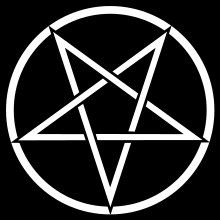
Theistic Satanism, otherwise referred to as religious Satanism, spiritual Satanism, or traditional Satanism,[2] is an umbrella term for religious groups that consider Satan, the Devil, to objectively exist as a deity, supernatural entity, or spiritual being worthy of worship or reverence, whom individuals may contact and convene with, in contrast to the atheistic archetype, metaphor, or symbol found in LaVeyan Satanism.[2][3][4]
Organizations who uphold theistic Satanist beliefs most often have few adherents, are loosely affiliated or constitute themselves as independent groups and cabals, which have largely self-marginalized.[5] Another prominent characteristic of theistic Satanism is the use of various types of magic.[2] Most theistic Satanist groups exist in relatively new models and ideologies, many of which are independent of the Abrahamic religions.[2][4][6]
In addition to worship of the Devil in the Abrahamic sense, religious traditions based on the worship of other "adversarial" gods—usually borrowed from pre-Christian polytheistic religions—are often included within theistic Satanism, and most theistic Satanist groups exist in relatively new models and ideologies.[2] Theistic Satanist organizations may incorporate beliefs and practices borrowed from Gnosticism, Hermeticism, Neo-Paganism, New Age, the left-hand path, black magic, ceremonial magic, Crowleyan magick, Western esotericism, occult traditions, and sorcery.[2][4][7]
- ^ Petersen 2005, pp. 444–446.
- ^ a b c d e f Abrams, Joe (Spring 2006). Wyman, Kelly (ed.). "The Religious Movements Homepage Project – Satanism: An Introduction". virginia.edu. University of Virginia. Archived from the original on 29 August 2006. Retrieved 30 December 2020.
- ^ Partridge 2004, p. 82.
- ^ a b c Lewis, James R. (August 2001b). "Who Serves Satan? A Demographic and Ideological Profile". Marburg Journal of Religion. 6 (2). University of Marburg: 1–25. doi:10.17192/mjr.2001.6.3748. ISSN 1612-2941. Retrieved 30 December 2020.
- ^ Holt & Petersen 2016, pp. 447–448.
- ^ Petersen 2005, pp. 424–427, 442–443.
- ^ Petersen 2005, pp. 424–427.